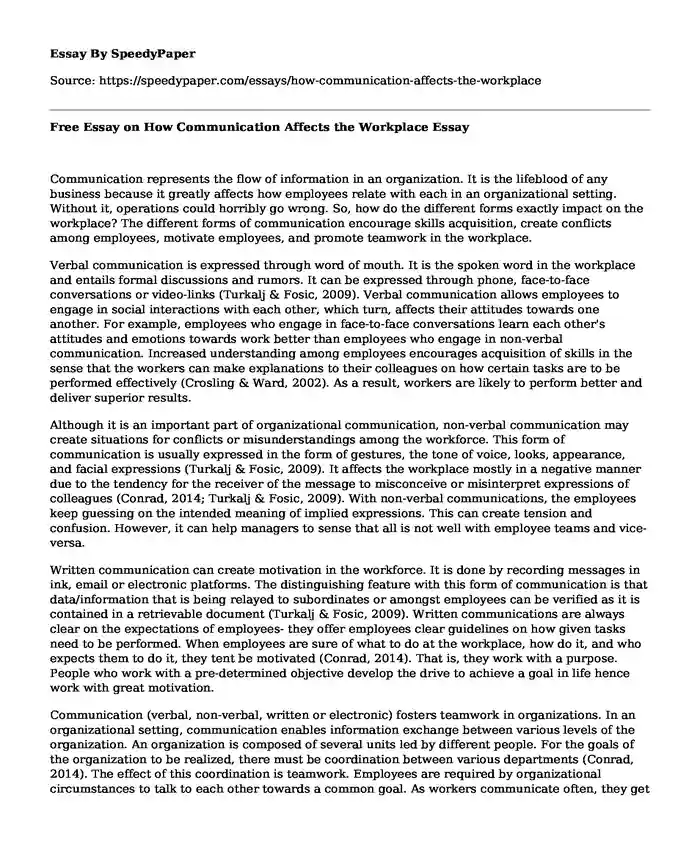
| Type of paper: | Essay |
| Categories: | Business communication |
| Pages: | 3 |
| Wordcount: | 670 words |
Communication represents the flow of information in an organization. It is the lifeblood of any business because it greatly affects how employees relate with each in an organizational setting. Without it, operations could horribly go wrong. So, how do the different forms exactly impact on the workplace? The different forms of communication encourage skills acquisition, create conflicts among employees, motivate employees, and promote teamwork in the workplace.
Verbal communication is expressed through word of mouth. It is the spoken word in the workplace and entails formal discussions and rumors. It can be expressed through phone, face-to-face conversations or video-links (Turkalj & Fosic, 2009). Verbal communication allows employees to engage in social interactions with each other, which turn, affects their attitudes towards one another. For example, employees who engage in face-to-face conversations learn each other's attitudes and emotions towards work better than employees who engage in non-verbal communication. Increased understanding among employees encourages acquisition of skills in the sense that the workers can make explanations to their colleagues on how certain tasks are to be performed effectively (Crosling & Ward, 2002). As a result, workers are likely to perform better and deliver superior results.
Although it is an important part of organizational communication, non-verbal communication may create situations for conflicts or misunderstandings among the workforce. This form of communication is usually expressed in the form of gestures, the tone of voice, looks, appearance, and facial expressions (Turkalj & Fosic, 2009). It affects the workplace mostly in a negative manner due to the tendency for the receiver of the message to misconceive or misinterpret expressions of colleagues (Conrad, 2014; Turkalj & Fosic, 2009). With non-verbal communications, the employees keep guessing on the intended meaning of implied expressions. This can create tension and confusion. However, it can help managers to sense that all is not well with employee teams and vice-versa.
Written communication can create motivation in the workforce. It is done by recording messages in ink, email or electronic platforms. The distinguishing feature with this form of communication is that data/information that is being relayed to subordinates or amongst employees can be verified as it is contained in a retrievable document (Turkalj & Fosic, 2009). Written communications are always clear on the expectations of employees- they offer employees clear guidelines on how given tasks need to be performed. When employees are sure of what to do at the workplace, how do it, and who expects them to do it, they tent be motivated (Conrad, 2014). That is, they work with a purpose. People who work with a pre-determined objective develop the drive to achieve a goal in life hence work with great motivation.
Communication (verbal, non-verbal, written or electronic) fosters teamwork in organizations. In an organizational setting, communication enables information exchange between various levels of the organization. An organization is composed of several units led by different people. For the goals of the organization to be realized, there must be coordination between various departments (Conrad, 2014). The effect of this coordination is teamwork. Employees are required by organizational circumstances to talk to each other towards a common goal. As workers communicate often, they get to know each other and how their duties interact. This creates a sense of teamwork.
As a conclusion, it can be said that all forms of communication can have both negative and positive effects regarding organizational performance. Communication can help employees acquire skills by talking to each or during presentations. It can also motivate, create conflicts as well as foster teamwork. Since the effects can be both positive and negative, it is upon the leaders to carefully a select a form of communication fitting a particular situation to avoid negatively affecting employee commitment.
References
Conrad, D. (2014). Workplace communication problems: Inquiries by employees and applicable solutions. Journal of Business Studies Quarterly, 5(4), 105-116.
Crosling, G., & Ward, I. (2002). Oral communication: the workplace needs and uses of business graduate employees. English for Specific Purposes, 21(1), 41-57. doi:10.1016/s0889-4906(00)00031-4
Turkalj, Z., & Fosic, I. (2009). Organizational communication as an important factor of organizational behaviour. Interdisciplinary Management Research, 5(2009), 33-42.
Cite this page
Free Essay on How Communication Affects the Workplace. (2022, Jul 08). Retrieved from https://speedypaper.com/essays/how-communication-affects-the-workplace
Request Removal
If you are the original author of this essay and no longer wish to have it published on the SpeedyPaper website, please click below to request its removal:
- Free Essay on How the Internet Has Helped LGBT Youth over the Past Few Years
- Essay Example on How Art Benefit's Children
- Essay Sample on Kansas' Climate
- Essay Exaple for Free: Self-Determination Theory and Motivation
- American Colonial Painters Essay Sample
- Free Essay Sample. Cancer of the Brain
- Essay Sample on Napoleon Bonaparte and the Humanities
Popular categories




